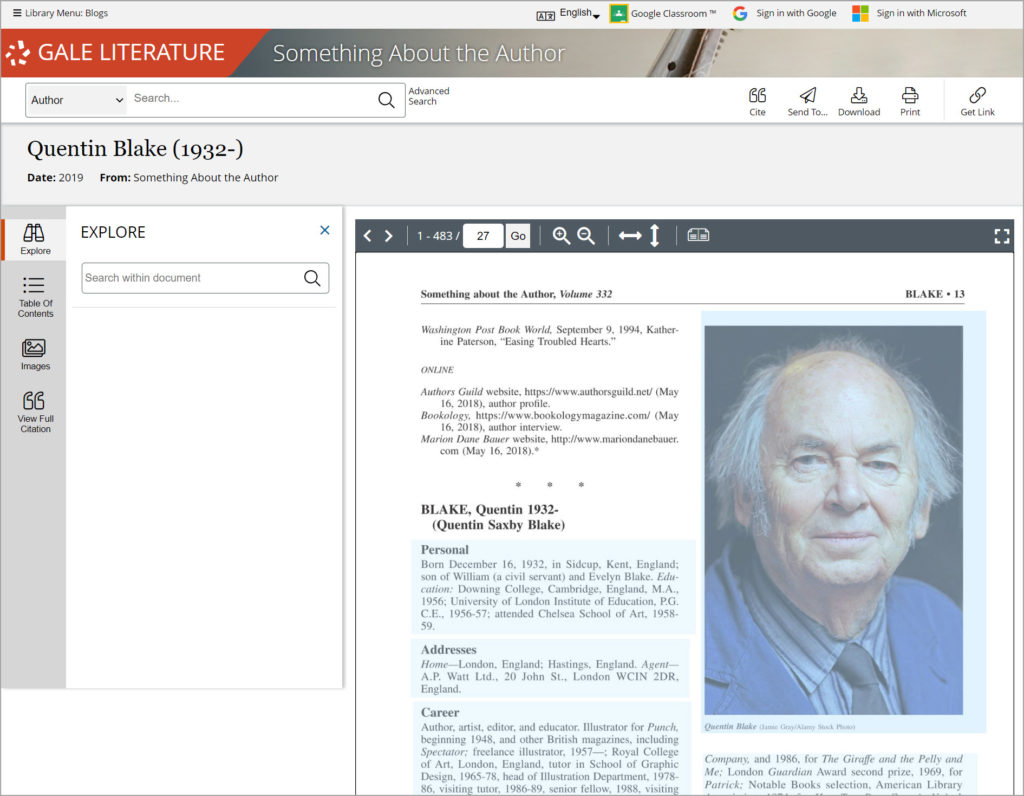| By Gale Staff |
Where would any of us be without Dr. Seuss, Shel Silverstein, or Eric Carle?
The first full week in February is Children’s Authors and Illustrators Week, a time to celebrate the creators who bring magic to storytime and inspire children’s literacy. Elementary educators and public librarians can leverage the resources in the Gale Literature: Something About the Author series to further research key figures in children’s literature.
Children’s Authors and Illustrators Week was created to help more young people fall in love with reading. Each February, Children’s Authors Network! (CAN!) coordinates special events around the country for children’s authors and illustrators to visit libraries, bookstores, schools, and other learning spaces. They often host storytimes, hand out free books, or facilitate workshops. With a little help from Something About the Author, you can create your own ways to get kids excited about reading.
Explore Your Favorite Authors
Something About the Author features digital content on more than 12,000 authors and illustrators. Each entry includes a photo and information on the artist’s life, career, works, adaptations, and more. Volumes feature interesting facts and an easy-to-read narrative that offers a snapshot of the author or illustrator’s life.
For example, Eric Carle, author and illustrator of the beloved children’s book The Very Hungry Caterpillar, grew up in Germany during World War II. A dedicated art teacher encouraged Carle’s childhood love for art, despite the strict rules and harsh discipline of wartime Germany. Eventually, Carle found joy in creating stories and art, becoming a wildly successful children’s author.
Roald Dahl is another well-adored figure in children’s literature—as was his illustrator, Quentin Blake. Dahl experienced all kinds of misadventures as a child, and many of his personal experiences received fantastical retellings in books like Charlie and the Chocolate Factory and Matilda. Dahl was injured during World War II, and he considered his path to becoming an author as more of an accident than an intentional decision. Most of his life, like the stories he would pen, was somewhat disconnected from reality—Dahl married a movie star and was allegedly a spy during the war.

Students and patrons will feel inspired by the personal journeys of their favorite children’s authors and illustrators. The Gale Literature: Something About the Author series lets students build connections and expand their critical thinking skills as they study an author’s background via a clear, easy-to-navigate research platform.
Discussion Idea: Have students select a favorite children’s author or illustrator. Ask them to research that individual’s biographical information using Something About the Author. Encourage students to identify connections between the author’s life and the themes of their books.
More Ways to Celebrate Children’s Authors and Illustrators Week
There is no limit to the creative ways to celebrate this special observance.
- Ask your library staff to create a collection of their favorite children’s stories. Have these books on display in the children’s section of your library with a short biography of the author or illustrator.
- Teachers can help students write a letter to their favorite children’s writers and illustrators, sharing what they love about their work. Many of these artists have contact information on their websites, so you can mail or email the letters.
- Have students bring their favorite children’s books from home to share with the class. Dedicate reading time every day for students to explore one another’s stories or research to author’s biography. At the end of the week, let students vote on their favorite stories and authors.
- Encourage students to create their own children’s stories. Once written and illustrated, help them “bind” their books with a three-hole punch and binder rings.
- Foreign language instructors might find copies of popular children’s stories in French, Spanish, or other languages. For example, Where the Wild Things Are has been translated into more than 40 different languages. Have your older students practice their foreign language skills using one of their beloved stories.
- While not always possible, see if anyone in your network of teachers or librarians has a connection to a children’s author or illustrator. Local writers are often happy to attend schools or libraries to discuss or read their work.
Interested in learning more? Request a demo or trial of Gale Literature: Something About the Author.

